人教版七年级英语下册Unit9说课稿Unit7Whatdoeshelooklike
- 格式:doc
- 大小:35.50 KB
- 文档页数:6
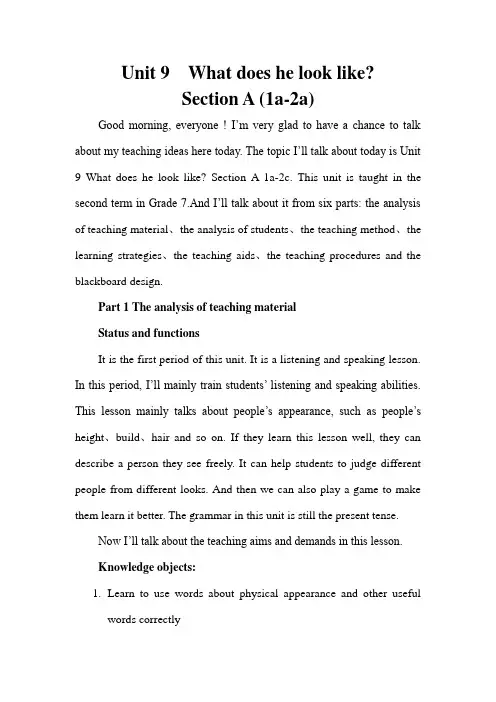
Unit 9 What does he look like?Section A (1a-2a)Good morning, everyone ! I’m very glad to have a chance to talk about my teaching ideas here today. The topic I’ll talk about today is Unit 9 What does he look like? Section A 1a-2c. This unit is taught in the second term in Grade 7.And I’ll talk about it from six parts: the analysis of teaching material、the analysis of students、the teaching method、the learning strategies、the teaching aids、the teaching procedures and the blackboard design.Part 1 The analysis of teaching materialStatus and functionsIt is the first period of this unit. It is a listening and speaking lesson. In this period, I’ll mainly train students’ listening and speaking abilities. This lesson mainly talks about people’s appearance, such as people’s height、build、hair and so on. If they learn this lesson well, they can describe a person they see freely. It can help students to judge different people from different looks. And then we can also play a game to make them learn it better. The grammar in this unit is still the present tense.Now I’ll talk about the teaching aims and demands in this lesson.Knowledge objects:1.Learn to use words about physical appearance and other usefulwords correctlyheight、build、tall、short、heavy、thin、curly、straight、handsome、actress、actor、singer2.Learn to use the expressions correctly:be of medium height/ build、go to the cinema、see you later、first of all、in the end、a little3.Learn how to ask other’s appearance and how to give the rightanswersWhat does he look like?He is short/ tall /heavy/ thin/ of medium height/ of medium build.What does he look like?He has short hair/ a round face/ two big eyes…-Is he tall or short? - He is short.-Does he have curly or straight hair? -He has straight hair.Ability Objects:1.To develop the students’ listening and speaking abilities.2.To train the students’ ability of working in pairs.3.To develop the students’ ability of communication by learning theuseful structures.Moral Objects:To train the students to be friendly to others get on well with each other.Teaching key points:1. Learn to use the expressions correctly:be of medium height/ build、go to the cinema、see you later、first of all、in the end、a little2. Learn how to ask other’s appea rance and how to give the rightanswerWhat does he look like?He is short/ tall /heavy/ thin/ of medium height/ of medium build.What does he look like?He has short hair/ a round face/ two big eyes…Teaching difficult points:When they describe a person’s appearance, the students should know how to use “be” and “have” correctlyPart 2 The analysis of studentsThe students have learned English for more than half a year so far. They can understand each other well. They have showed great interest in English. They want to express themselves but they are lack of vocabularies. Most of them don’t often use English to communicate with others. Some of them are not active in the class because they are afraid of making mistakes. In order to encourage them to express themselves in front of others, I’ll create some real situations for them to practice the key words and structures.Part 3 Teaching methodsTask-based teaching methodsThe situational teaching methodAs we all know, the main aims of learning English in middle school is to cultivate students four basic skills and their good sense of the English language. So in this lesson I’ll mainly use the Task-based teaching method and the situational teaching method. That is to say, I’ll let the students learn in the real situations and finish tasks by listening and making dialogs. That can help students to get a better understanding of the key structures.And in this lesson, communication method isPart 4 Learning methodsIn this lesson, I’ll let them work in groups and pairs to practice the knowledge they have learned. In this way, they can learn better. Work in groups or pairs can also improve their ability of communication.Before we learn a new lesson, I always ask them to preview it. After they preview the new lesson, they can learn about the items and know the important and difficult points. And then, they will concentrate more on the knowledge that they don’t understand well. It can make them learn easily in classPart 5 Teaching aidsWith the tape player, pictures and chat, the class goes well.Part 6 Teaching proceduresIn this lesson, I’ll finish it in 5 steps.Step 1 Lead inIn this step, first, I’ll show them two pictures: Yao Ming and Pan Changjiang. I’ll tell them like this: This is Yao Ming. He is tall; This is Pan Changjiang. He is short.Then I’ll show them more pictures of famous people to lead in the new words in this lesson. When they know the words well, I will let them finish 1a. match the words with the people in the picture. Next, I’ll go on Step 2 PresentationStep 2 Presentation and oral practiceLook at the pictures and ask the students: What does he look like?First, I’ll help them answer: He is thin. He is tall. He has long curly black hair.What does she look like?She is heavy. She is of medium height. She has short straight black hair.Next, I’ll let them talk about other pictures together.Oral practiceLook at the pictures on ppt page, ask the students to point at the person in the picture, ask and answer like this: What does he/ she look like?He/ She is……He/ She has…..When they practice, I’ll tell them pay more attention to the use of “be” and “have”. When they finish practicing, I’ll ask some of them to tell the students when to use “be” and when to use “have”. And then, I’ll show them another group pictures to practice the structures.Step 3 Listening PracticeAfter they practice the dialogue, they have known how to describe a person and mastered the words and structures.Next. I’ll let them do some lis tening practice. They may understand the dialogue easily after practicing the dialogue and they can fill in the blanks correctly.The answers: 1. tall 2. curly 3. hairStep 4 Game TimeThe name of this game is called stand up.Students are divided two teams like boys and girls to describe what Doraemon looks like according to the pictures. Who stand up first and clap his palm can give the answers .The team lists more wins this game.If they can learn this well, they will do better in the next activity.Step 5 Consolidation and homeworkIn this step, I’ll finish 2a. After they have so much speaking practice, I think they can find out the answer easily.As for 2a, I’ll ask them to read the sentences out and think up theirown answers, and then listen to the tape to get the right answer.Then give them some related drills about what they learned in class.These three parts are arranged to have ss practice from words to sentenced.HomeworkIt is said this is a criminal, Luffy. The marine police are finding him. So write a short passage to describe him to tell the marinepolice.Part 6 Blackboard DesignUnit 9 What does he look like?Section A (1a- 2c)What does he/she look like?has short hair.has long hair.has straight hair.has curly hair.He/Sheis tall/ short.is thin .is fat/heavy.is of medium build.is of medium height.。
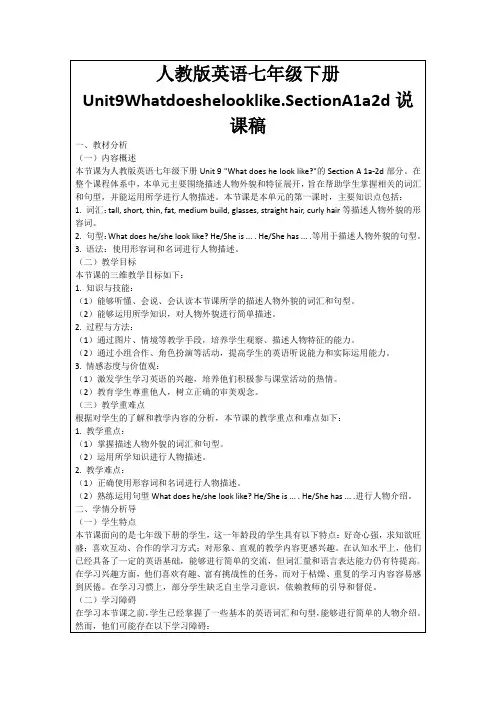
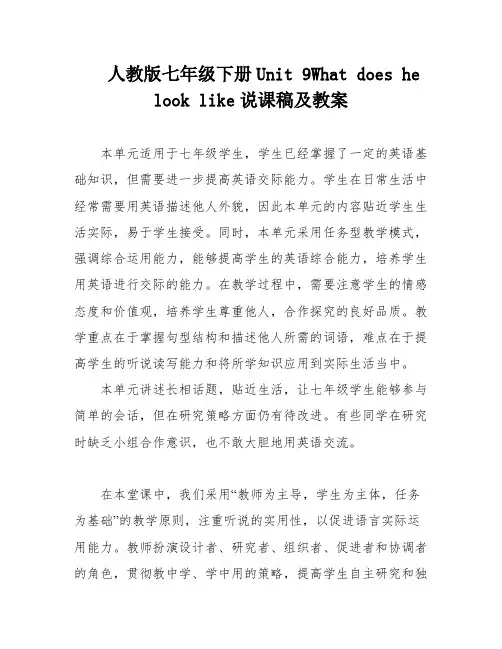
人教版七年级下册Unit 9What does he look like说课稿及教案本单元适用于七年级学生,学生已经掌握了一定的英语基础知识,但需要进一步提高英语交际能力。
学生在日常生活中经常需要用英语描述他人外貌,因此本单元的内容贴近学生生活实际,易于学生接受。
同时,本单元采用任务型教学模式,强调综合运用能力,能够提高学生的英语综合能力,培养学生用英语进行交际的能力。
在教学过程中,需要注意学生的情感态度和价值观,培养学生尊重他人,合作探究的良好品质。
教学重点在于掌握句型结构和描述他人所需的词语,难点在于提高学生的听说读写能力和将所学知识应用到实际生活当中。
本单元讲述长相话题,贴近生活,让七年级学生能够参与简单的会话,但在研究策略方面仍有待改进。
有些同学在研究时缺乏小组合作意识,也不敢大胆地用英语交流。
在本堂课中,我们采用“教师为主导,学生为主体,任务为基础”的教学原则,注重听说的实用性,以促进语言实际运用能力。
教师扮演设计者、研究者、组织者、促进者和协调者的角色,贯彻教中学、学中用的策略,提高学生自主研究和独立思考的意识,激发学生自身的潜能和创造力,以任务型教学为课堂教学设计理念,具体采用情景交际教学法和参与式合作课堂教学法,突出学以致用。
通过以上教学方法的实施,我们调动学生的好奇心和研究兴趣,让学生在探究和合作中研究,使得课堂气氛活跃,最大限度地激发学生研究英语的兴趣,提高学生的英语水平。
在积极地参与、完成各项任务的过程中,学生自主研究语言,提高综合运用语言的能力,学会更好地与他人沟通,使各层次的学生都有所收获。
在这节课中,学生主要通过合作和对话来完成任务型教学。
在教学过程中,我们通过情景设计来导入本节课的主要内容,让学生通过图片展示研究新单词和短语,采用瞬间记忆的形式检查学生的掌握情况,训练学生的听说能力。
通过师生、生生互动,让学生熟悉新句式,并通过Pairwork的活动让学生掌握所学知识。

七年级英语下册Unit 9 What does he look like period 4说课稿人教新目标版一. 教材分析人教新目标版七年级英语下册Unit 9主要介绍了描述人物外貌的词汇和句型。
通过本节课的学习,学生能够掌握Look like, tall, short, slim, overweight等词汇,以及What does he/she look like? 和He/She looks like… 等句型。
此外,本节课还要求学生能够运用所学知识进行简单的日常交流,提高学生的口语表达能力。
二. 学情分析面对刚进入七年级的学生,他们对英语有了一定的了解,但口语表达能力尚待提高。
在学习过程中,学生需要通过大量的练习来熟练掌握词汇和句型。
此外,学生需要借助图片、情景等直观手段来更好地理解和运用所学知识。
三. 说教学目标1.知识目标:学生能够掌握描述人物外貌的词汇和句型,如Look like,tall, short, slim, overweight等。
2.能力目标:学生能够运用所学知识进行简单的日常交流,提高口语表达能力。
3.情感目标:通过本节课的学习,学生能够培养对英语学习的兴趣,增强自信心。
四. 说教学重难点1.重点:描述人物外貌的词汇和句型的掌握。
2.难点:运用所学知识进行实际交流,提高口语表达能力。
五. 说教学方法与手段1.情景教学法:通过设定各种真实的生活场景,让学生在实际情境中学习和运用词汇和句型。
2.交际法:引导学生进行角色扮演、小组讨论等互动活动,提高学生的口语表达能力。
3.直观教学法:利用图片、实物等直观手段,帮助学生更好地理解和记忆所学知识。
4.任务型教学法:设计各种任务,让学生在完成任务的过程中运用所学知识。
六. 说教学过程1.导入:通过展示一张明星照片,引导学生猜测明星是谁,激发学生的学习兴趣。
2.新课呈现:教师展示各种人物照片,引导学生用英语描述人物外貌,引入新词汇和句型。
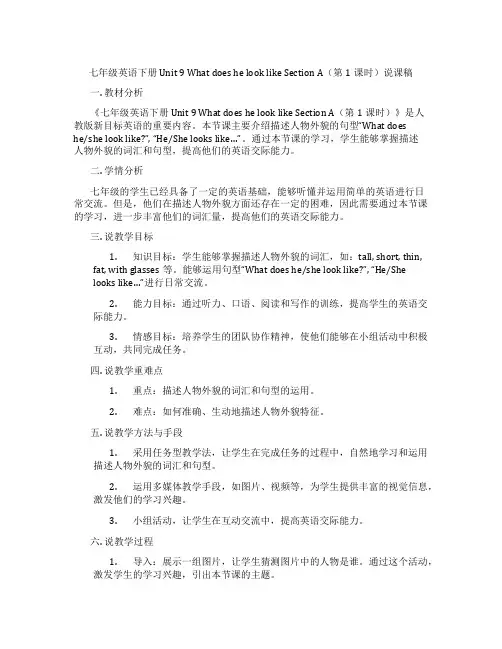
七年级英语下册 Unit 9 What does he look like Section A(第1课时)说课稿一. 教材分析《七年级英语下册 Unit 9 What does he look like Section A(第1课时)》是人教版新目标英语的重要内容。
本节课主要介绍描述人物外貌的句型“What doeshe/she look like?”, “He/She looks like…”。
通过本节课的学习,学生能够掌握描述人物外貌的词汇和句型,提高他们的英语交际能力。
二. 学情分析七年级的学生已经具备了一定的英语基础,能够听懂并运用简单的英语进行日常交流。
但是,他们在描述人物外貌方面还存在一定的困难,因此需要通过本节课的学习,进一步丰富他们的词汇量,提高他们的英语交际能力。
三. 说教学目标1.知识目标:学生能够掌握描述人物外貌的词汇,如:tall, short, thin,fat, with glasses等。
能够运用句型“What does he/she look like?”, “He/Shelooks like…”进行日常交流。
2.能力目标:通过听力、口语、阅读和写作的训练,提高学生的英语交际能力。
3.情感目标:培养学生的团队协作精神,使他们能够在小组活动中积极互动,共同完成任务。
四. 说教学重难点1.重点:描述人物外貌的词汇和句型的运用。
2.难点:如何准确、生动地描述人物外貌特征。
五. 说教学方法与手段1.采用任务型教学法,让学生在完成任务的过程中,自然地学习和运用描述人物外貌的词汇和句型。
2.运用多媒体教学手段,如图片、视频等,为学生提供丰富的视觉信息,激发他们的学习兴趣。
3.小组活动,让学生在互动交流中,提高英语交际能力。
六. 说教学过程1.导入:展示一组图片,让学生猜测图片中的人物是谁。
通过这个活动,激发学生的学习兴趣,引出本节课的主题。
2.新课呈现:通过展示图片和视频,引入描述人物外貌的词汇和句型。
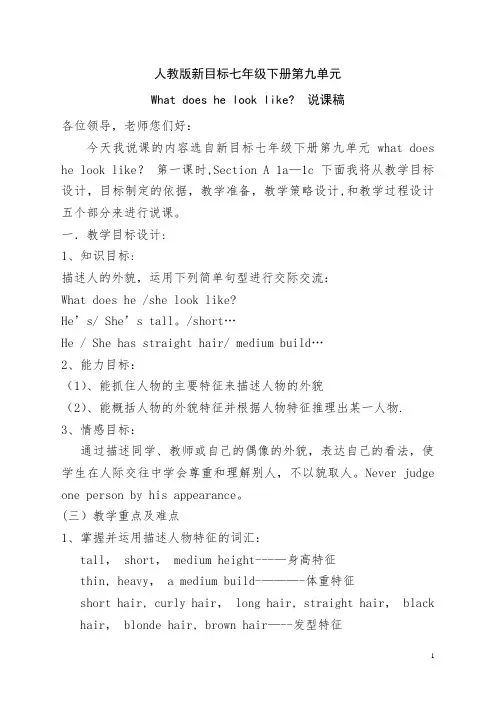
人教版新目标七年级下册第九单元What does he look like? 说课稿各位领导,老师您们好:今天我说课的内容选自新目标七年级下册第九单元 what does he look like?第一课时,Section A 1a—1c 下面我将从教学目标设计,目标制定的依据,教学准备,教学策略设计,和教学过程设计五个部分来进行说课。
一.教学目标设计:1、知识目标:描述人的外貌,运用下列简单句型进行交际交流:What does he /she look like?He’s/ She’s tall。
/short…He / She has straight hair/ medium build…2、能力目标:(1)、能抓住人物的主要特征来描述人物的外貌(2)、能概括人物的外貌特征并根据人物特征推理出某一人物.3、情感目标:通过描述同学、教师或自己的偶像的外貌,表达自己的看法,使学生在人际交往中学会尊重和理解别人,不以貌取人。
Never judge one person by his appearance。
(三)教学重点及难点1、掌握并运用描述人物特征的词汇:tall, short, medium height---—身高特征thin, heavy, a medium build-———-体重特征short hair, curly hair, long hair, straight hair, black hair, blonde hair, brown hair—--发型特征2、掌握并运用简单的英语交际句型:Is that your friend?No, it isn’t。
What does he/ she look like?He / She is…。
. /has…Do you know ….?No, what does he / she look like?3.难点:1)描述头发时形容词的排列顺序:长短+形状+颜色2)注意比较动词“has"和“is”在对人物进行描述时的用法及汉语意思的差别。
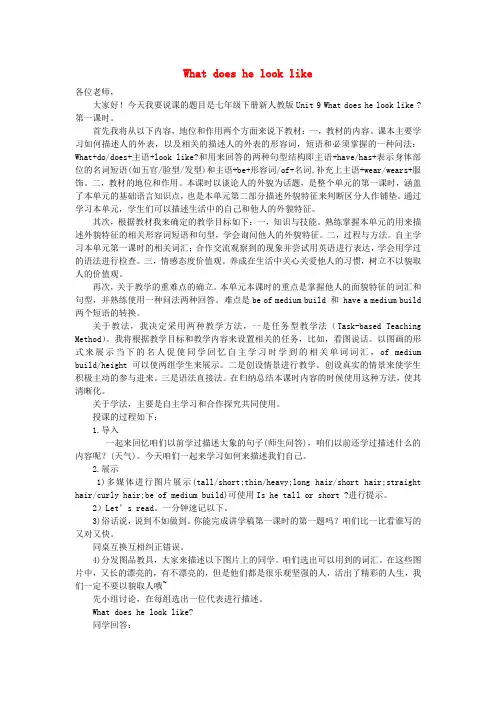
What does he look like各位老师,大家好!今天我要说课的题目是七年级下册新人教版Unit 9 What does he look like ?第一课时。
首先我将从以下内容,地位和作用两个方面来说下教材:一,教材的内容。
课本主要学习如何描述人的外表,以及相关的描述人的外表的形容词,短语和必须掌握的一种问法:What+do/does+主语+look like?和用来回答的两种句型结构即主语+have/has+表示身体部位的名词短语(如五官/脸型/发型)和主语+be+形容词/of+名词,补充上主语+wear/wears+服饰。
二,教材的地位和作用。
本课时以谈论人的外貌为话题,是整个单元的第一课时,涵盖了本单元的基础语言知识点,也是本单元第二部分描述外貌特征来判断区分人作铺垫。
通过学习本单元,学生们可以描述生活中的自己和他人的外貌特征。
其次,根据教材我来确定的教学目标如下:一,知识与技能。
熟练掌握本单元的用来描述外貌特征的相关形容词短语和句型,学会询问他人的外貌特征。
二,过程与方法。
自主学习本单元第一课时的相关词汇;合作交流观察到的现象并尝试用英语进行表达,学会用学过的语法进行检查。
三,情感态度价值观。
养成在生活中关心关爱他人的习惯,树立不以貌取人的价值观。
再次,关于教学的重难点的确立。
本单元本课时的重点是掌握他人的面貌特征的词汇和句型,并熟练使用一种问法两种回答。
难点是be of medium build 和 have a medium build 两个短语的转换。
关于教法,我决定采用两种教学方法,一是任务型教学法(Task-based Teaching Method)。
我将根据教学目标和教学内容来设置相关的任务,比如,看图说话。
以图画的形式来展示当下的名人促使同学回忆自主学习时学到的相关单词词汇,of medium build/height 可以使两组学生来展示。
二是创设情景进行教学。
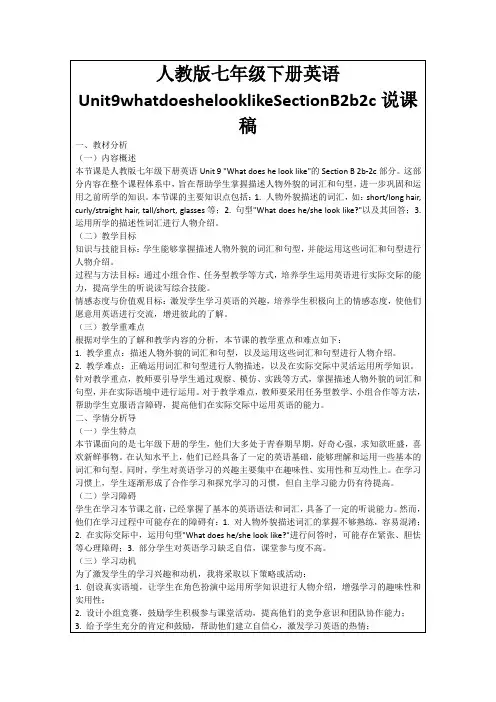
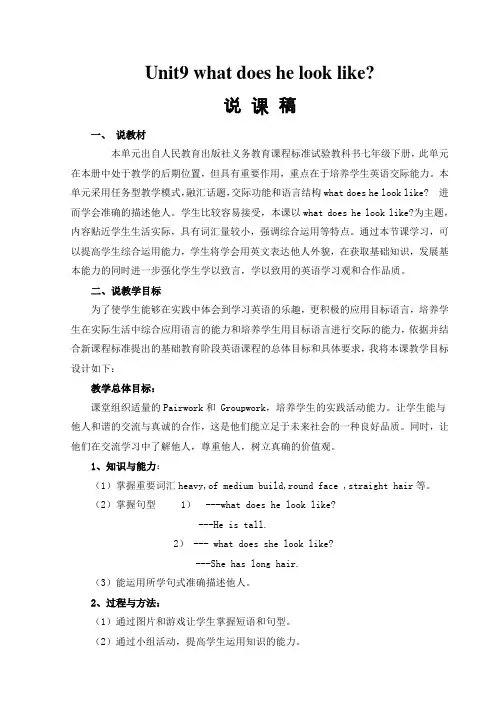
Unit9 what does he look like?说课稿一、说教材本单元出自人民教育出版社义务教育课程标准试验教科书七年级下册,此单元在本册中处于教学的后期位置,但具有重要作用,重点在于培养学生英语交际能力。
本单元采用任务型教学模式,融汇话题,交际功能和语言结构what does he look like? 进而学会准确的描述他人。
学生比较容易接受,本课以what does he look like?为主题,内容贴近学生生活实际,具有词汇量较小,强调综合运用等特点。
通过本节课学习,可以提高学生综合运用能力,学生将学会用英文表达他人外貌,在获取基础知识,发展基本能力的同时进一步强化学生学以致言,学以致用的英语学习观和合作品质。
二、说教学目标为了使学生能够在实践中体会到学习英语的乐趣,更积极的应用目标语言,培养学生在实际生活中综合应用语言的能力和培养学生用目标语言进行交际的能力,依据并结合新课程标准提出的基础教育阶段英语课程的总体目标和具体要求,我将本课教学目标设计如下:教学总体目标:课堂组织适量的Pairwork和 Groupwork,培养学生的实践活动能力。
让学生能与他人和谐的交流与真诚的合作,这是他们能立足于未来社会的一种良好品质。
同时,让他们在交流学习中了解他人,尊重他人,树立真确的价值观。
1、知识与能力:(1)掌握重要词汇heavy,of medium build,round face ,straight hair等。
(2)掌握句型 1) ---what does he look like?---He is tall.2) --- what does she look like?---She has long hair.(3)能运用所学句式准确描述他人。
2、过程与方法:(1)通过图片和游戏让学生掌握短语和句型。
(2)通过小组活动,提高学生运用知识的能力。
3、情感态度与价值观:(1)让学生学会在与别人交流的过程中了解他人,尊重他人。
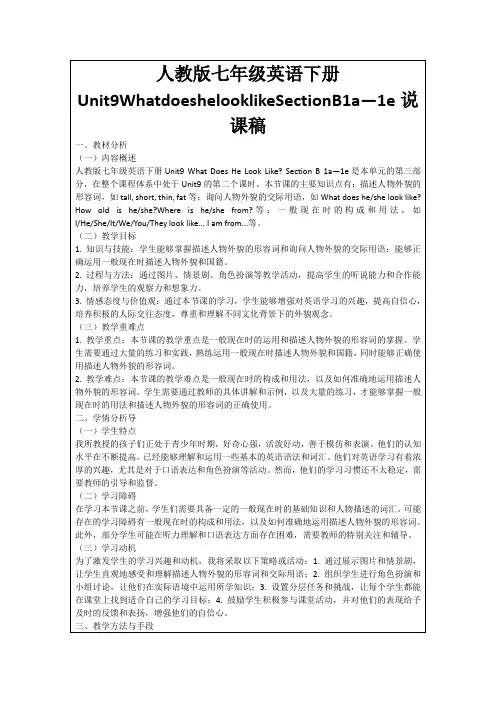

人教版七年级英语下册Unit9 说课稿Unit9 What does he look like?尊敬的各位领导,各位同行,大家好!今天我的说课内容是人民教育出版社七年级英语下册第9单元:What does he look like?的第一课时:Section A 1a~granmmar Focus.接下来,我将从以下几个方面来进行说明。
一、领悟教材本单元是以人的外貌特征为主线,兼顾交际功能的学习,以一种循序渐进的方式引导学生学会用英语介绍自己或他人的外貌。
在第一课时中,主要是让学生学会“What •look like?”这个句型,同时掌握表示发型、身高、身材的形容词和词组。
第一课时是我们整个单元基础性学习,这为本单元的其他课时进行深入、拓展性学习奠定了基础。
二、确立教学目标1)、知识目标A、描述身高、体重、发型的形容词B、句型:--What ..... look like? 以及相应答语的学习C、is/has在描述人物外貌时的用法区别2)、能力目标---能运用What.....look like?这个句型谈论人物外貌。
3)、情感目标---通过小组合作学习的过程,友好描述自己和他人的外貌,以此加强同学间的相互了解,交新朋友.三、重难点的确立根据本节课的教学内容和目标,我将教学重点和难点设计如下:(一)、重点:句型What.....look like? 的掌握和运用。
新词汇:long、curly 、tall、of medium height 、short、thin 、of medium build, heavy 、straight等等(二)、难点:以What.....look like?为主线,来进行人物外貌描述口语交际活动。
四、教法选择和学法指导1、教学方法根据教材特点和学生的心里特点,遵循以“教师为主导,学生为主题”的原则,在本堂课的教学中我会采用以下教学方法:全身反应教学法(TPR)---任务型教学法.2、学法指导对于学生来说,学法的指导和学习习惯的培养尤为重要,这是他们走向主体性学习的最根本途径。
七年级英语下册 Unit 9 What does he look like Section B(第3课时)说课稿一. 教材分析《新目标》英语七年级下册Unit 9 What does he look like? Section B(第3课时)的主要内容是通过描述一个人的外貌、穿着和发型等特征来练习一般疑问句和回答。
本节课的主要语言点是一般疑问句的构成以及如何用Yes/No或简短回答来回答问题。
同时,学生还需要学会如何用形容词来描述一个人的外貌特征。
二. 学情分析通过对学生的了解,我们知道他们已经掌握了基本的英语语法和词汇,对一般疑问句也有了一定的理解。
但是,学生可能对如何用英语描述一个人的外貌特征还不够熟悉,因此需要通过实例和练习来加强这方面的训练。
三. 说教学目标1.学生能够听懂、会说、会读本节课的主要词汇和句型。
2.学生能够用英语描述一个人的外貌特征。
3.学生能够用一般疑问句来询问并回答关于某人的外貌特征。
四. 说教学重难点1.重点:学生能够听懂、会说、会读本节课的主要词汇和句型,并用它们来描述一个人的外貌特征。
2.难点:学生能够正确使用一般疑问句来询问并回答关于某人的外貌特征。
五. 说教学方法与手段在本节课的教学过程中,我将采用任务型教学法,通过各种任务和练习来让学生在实际语境中使用英语。
同时,我还会使用多媒体教学手段,如图片、视频等,来帮助学生更好地理解和记忆。
六. 说教学过程1.导入:通过展示一张明星的照片,引导学生用英语描述他的外貌特征,激发学生的兴趣。
2.新课呈现:通过讲解和示例,教授本节课的主要词汇和句型。
3.练习:通过各种练习,让学生在实际语境中使用所学知识。
4.巩固:通过小组活动,让学生互相描述外貌特征,巩固所学知识。
5.总结:对本节课的内容进行总结,强调重点和难点。
七. 说板书设计板书设计将包括本节课的主要词汇和句型,以及一般疑问句的构成。
通过板书,学生可以清晰地了解本节课的学习内容。
七年级英语下册 Unit 9 What does he look like说课稿(人教新目标版)一. 教材分析教材是英语教学的基础,本课所使用的是人教新目标版的七年级英语下册。
本单元的主题是描述一个人的外貌特征,主要涉及到形容词和询问外貌的交际用语。
通过学习本单元,学生能够掌握相应的词汇和句型,并能够运用所学知识进行实际交流。
二. 学情分析学生在进入七年级时已经掌握了基本的英语语法和一定数量的词汇,但对于描述一个人的外貌特征的表达方式可能还不够熟练。
此外,学生可能对于一些新的形容词和询问外貌的交际用语还不够熟悉,因此需要通过本节课的学习来进一步巩固和提高。
三. 说教学目标1.知识目标:学生能够掌握描述一个人外貌特征的词汇和句型,并能够熟练运用所学知识进行实际交流。
2.能力目标:学生能够通过听、说、读、写的活动,提高自己的英语交际能力,并能够运用所学知识进行创造性表达。
3.情感目标:通过学习本节课,学生能够增强对英语学习的兴趣和自信心,培养积极的学习态度。
四. 说教学重难点1.教学重点:学生能够掌握描述一个人外貌特征的词汇和句型,并能够熟练运用所学知识进行实际交流。
2.教学难点:学生能够灵活运用所学知识进行创造性表达,尤其是在不同的语境中能够正确使用形容词和询问外貌的交际用语。
五. 说教学方法与手段本节课采用任务型教学法,通过各种交际活动,让学生在实践中学习和运用语言。
同时,利用多媒体教学手段,如图片、视频等,来辅助教学,增加学生的学习兴趣和参与度。
六. 说教学过程1.导入:通过展示一组图片,让学生猜测图片中的人物是谁,激发学生的学习兴趣。
2.新课呈现:教师通过展示一张人物图片,引入本节课的主题,并引导学生用英语描述图片中的人物外貌特征。
3.学生练习:学生两人一组,互相描述对方的外貌特征,并运用所学句型进行交流。
4.小组活动:学生分成小组,根据教师提供的信息,制作一个,列出不同人物的外貌特征。
5.总结与展示:每个小组的代表上台展示他们制作的,并简要介绍他们小组的成员。
Unit 9 What does he look like?说课稿good morning! ladies and gentlemen! it’s my hornor to be here to share my speech with all of you. today my topic i’ll talk about is what does he look like? . from 1a to 1c of unit7 book1b. i will explain my lesson from the following 6 parts: teaching material analysisstudents analysisteaching important and difficult points analysisteaching strategies analysisteaching procedures analysisblackboard designthe topic is about how to describe people. it is close to students’ daily life. so it is helpful to raise learning interests of the students and it will be also helpful to improve their spoken english. there are many new words and expressions, such as hair, curly, straight, medium build and medium height…etc.so teaching the new words and the expressions may be the most important knowledge aim. after that, the students must be able to describe different people with them. during the class, the teacher must tell the students not to judge the people by their appearance and they should be friendly to each other.the students have known how to answer the special questions and have mastered some words and expressions .they show great interests in english.maybe it is a little difficult for some students to use so many new words and expressions correctly. it is also the teaching difficult point in this lesson. so i will use some different kinds of teaching methods , such as task-based method, communicative method, cooperative method, audio-visual teaching method . and in this lesson i’ll use powerpoint and real objects as the teaching aids.well, how to achieve my teaching theory, to stress the key points and break through the difficult points? the following i’ll talk about is my teaching procedures.step1 greetings and warming upto make the students feel happy and relaxed in my class, firstly i will encourage them to use the useful expressions they have learned to communicate with me. do you have a good friend? can you tell me something about her/him?… etc.then i’ll use two different rulers to revise the word short and long.step 2 presentation and practiceafter that i’ll use an interesting cartoon movie and some pictures to teach the new words and expressions in this class.i think the audio-visual teaching method can catch their attention quickly.then i’ll ask them to practice the patterns by a flash.step 3 exercise and listeningnext i’ll get them to do some exercises and the listening.first, get students to match the words with the people in the picture. then i play the recorder, students do activity 1b.this step can practice the students’ listening ability. and it can be considered as the summarize work of this lesson, because it can check the students if they’ve remembered the key point and difficult point.step 4 groupworkin order to help the students consolidate the knowledge they have learned in this lesson and show their team spirit,i adopt the cooperative teaching method. here i set a scene: a thief is stealing something in a supermarket. two kids find it and tell thepolicewoman about it. then divide the students into groups,three students a group,one of them acts as the policewoman .ask and answer like this: is he tall or short? is he heavy or thin? does he have short or long hair?.......at the time ,i tell the students not to judge a person by appearance and they should be friendly to each other.step 5 summarynext i’ll sum up the grammar with them.i think this step can help the students remind the knowledge they have learned in this lesson.step 6 homeworkat last,i’ll give them some homework, it’s very simple,but i think it is necessary for the students to do some extensive exercises after class.i’ll write the new words and expressions on the left of the blackboard. on the right, i’ll write the new patterns like this :teaching reflection:because the content the students will learn is closely related with their own, they should be very interested in them . after my teaching, i’m sure that they have a strong desire to express themselves. it will be helpful to improve their ability of communication.that’s all. thank you!。
人教版七年级英语下册Unit9 说课稿
Unit9 What does he look like?
尊敬的各位领导,各位同行,大家好!今天我的说课内容是人民教育出版社七年级英语下册第9单元:What does he look like?的第一课时:Section A 1a~granmmar Focus.接下来,我将从以下几个方面来进行说明。
一、领悟教材本单元是以人的外貌特征为主线,兼顾交际功能的学习,以一种循序渐进的方式引导学生学会用英语介绍自己或他人的外貌。
在第一课时中,主要是让学生学会“What •look like?”这个句型,同时掌握表示发型、身高、身材的形容词和词组。
第一课时是我们整个单元基础性学习,这为本单元的其他课时进行深入、拓展性学习奠定了基础。
二、确立教学目标
1)、知识目标A、描述身高、体重、发型的形容词
B、句型:--What ..... look like? 以及相应答语的
学习
C、is/has在描述人物外貌时的用法区别
2)、能力目标---能运用What.....look like?这个句型谈论人物外貌。
3)、情感目标---通过小组合作学习的过程,友好描述自己和他人的外貌,以此加强同学间的相互了解,交新朋友.
三、重难点的确立根据本节课的教学内容和目标,我将教学重
点和难点设计如下:
(一)、重点:句型What.....look like? 的掌握和运用。
新词汇:long、curly 、tall、of medium height 、
short、thin 、of medium build, heavy 、straight
等等
(二)、难点:以What.....look like?为主线,来进行人物外貌描述
口语交际活动。
四、教法选择和学法指导
1、教学方法根据教材特点和学生的心里特点,遵循以“教师为主导,学生为主题”的原则,在本堂课的教学中我会采用以下教学方法:全身反应教学法(TPR)---任务型教学法.
2、学法指导对于学生来说,学法的指导和学习习惯的培养尤为重要,这是他们走向主体性学习的最根本途径。
为了创造一个轻松愉快的学习、交流环境,培养学生综合运用这些知识的能力。
在本课教学中我会指导学生采用合作式学习、发现式学习等多种学习方法。
六、教学流程
(一)、情景创设,激发兴趣
1、让学生观看多媒体播放的课件《名人》,并观察人物外貌特点
2、让学生观看图片的同时,向学生提出以下几个问题:Who are they? Do you like him/her? What does he look like? (设计目的:
杨幂、周杰伦都是青少年们非常喜爱的众多名人中的其中几个,让学生观看他们的图片以此激发学生的兴趣,What does he/she look like?对于最后一个问题,学生就会回答不上来,在这里给学生留下一个悬念,同时将课堂引入正题。
)
(二)、词汇学习,加深记忆词汇学习环节分为三个阶段:学单词——记单词-——练单词
1、学单词展示几幅人物外貌的图片,然后采用老师领读,学生跟读的方式学习本节课的新单词。
(设计目的:通过观看图片,可以让学生更直接更形象的学习单词,以避免单词学习中容易出现的枯燥乏味等消极影响)
2、记单词遵循遗忘规律,只有不断地、及时的复习,才能加深知识在头脑中的记忆,那么,单词巩固环节是不可缺少的。
运用TPR教学法,复习词汇。
在这里主要表现为:老师说到一个描述人物外貌的单词或词组,觉得自己符合这个描述的同学就快速的站起来。
)
3、练单词出示一张与课本相同的图画,让学生翻开课本49页,完成书中1a部分的匹配题,然后听录音完成句子中的空格(帮助学生做出正确答案.)
(三)、句型学习,活学现用(1、直观形象学英语——2、七嘴八舌说英语——3、发散思维用英语)
1、直观形象学英语
1)、再次让学生观看多媒体出示的人物图片用图片中的人物为
例,老师引导学生对新句型的学习A、-- What does she look like? --She is thin/She has long hair B、-- What does he look like? --He has short hair. (学生跟读两遍,师生共同总结出句子结构:What +助动词+主语+look like?学生跟读两遍)
2)、(模仿练习)指着书本中的图片,让学生根据刚才所学的句型,谈论对图片中的人物。
3)、听录音,完成2a和2b并让学生跟读录音内容,(古语有云:授人以鱼不如授人以渔,因此,在学生完成听力之后,我会让学生与自己的搭档一起去寻找is/has的用法区别。
)Be+高矮胖瘦have+头发/眼睛(在这里让学生自己去寻找答案,一是培养学生的自主探索的学习能力,二是为了培养学生间的合作能力。
)2、七嘴八舌说英语情景交际
1)、what do you look like? I am …/I have …
2)、what does he/she look like? He/She is…He/She has…)
在这一环节,我会将学生分成2人一组的小团队,让他们运用以上句型进行情景对话,互相介绍自己和自己最喜欢的名人,并纠正在人物介绍时所出现的问题,几分钟后,叫学生来进行情景表演. 并为勇敢表演的小组送上一朵鲜花,以资鼓励!
3、发散思维用英语猜猜我是谁?将全班同学分为两组,每组选出一名同学来到讲台上背对黑板。
老师用多媒体播放两幅名人图片,然后分别请这两组同学向本组的组代表描述本组图片上人的外貌、工作或其他相关情况,比一比哪个小组最快猜到图片中
的人物。
在游戏过程中注意:首先要说出被猜的是哪几个名人(例如:周杰伦、成龙、姚明等,以缩小猜测范围,减小猜测难度)描述的时候,两组轮流描述,并且只能描述一句,并尽可能多的描述人物外貌,在很难猜出时,可以描述工作或其他相关情况。
(在以上两个环节中我设计了“情景交际”和“猜猜我是谁”两个不同的任务,让学生通过完成不同的任务来达到学习的目的,培养和提高学生语言综合运用能力及其概括能力,使学生在小组中交流、合作和竞争。
)
(四)、知识运用,集体操练选词填空,使句子意思完整。
is small eyes does heavy look has
1、What___he____like?
2、He___tall and____
3、My father __heavy.
4、My sister ___long hair.
5、Your brother has_____
(设计目的:这一环节是对本课知识的一个小结训练,同时也是本节课的一个课堂效果的反馈)
(五)、课后练习,巩固知识(家庭作业)
1、让学生用刚学过的知识,描述自己最喜欢的一个人,并将其写在一张自制的卡片上,并将卡片送给他/她.
2、搜集有关雷锋的图片或照片,第二天来向自己的搭档描述雷锋的外貌。
板书设计
What does he/she look like?
A、She is thin/She has long hair
B、He has short hair.
What do you look like?
A,I am tall
B,I have black hair.。